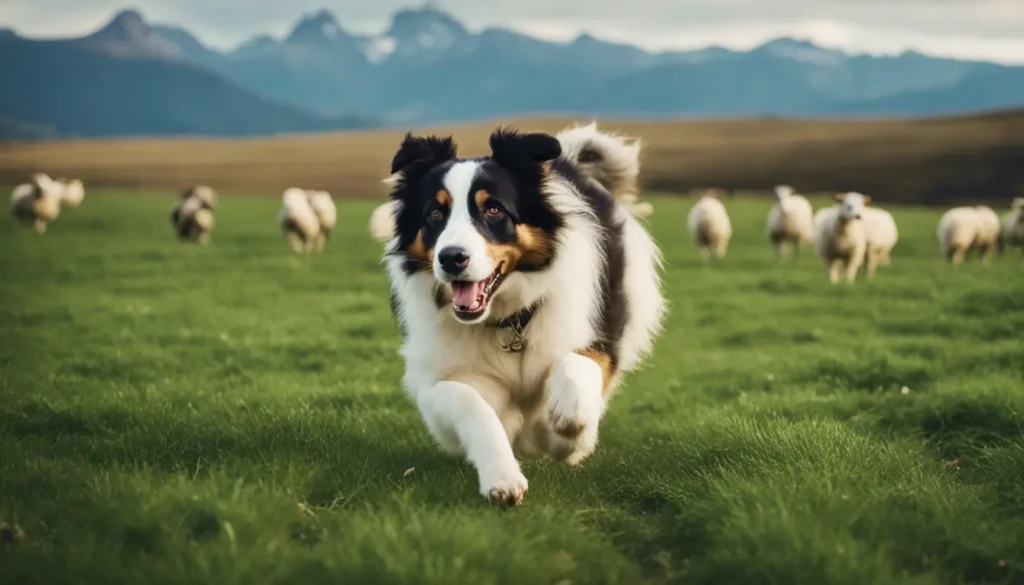As I sit on my back porch, pen in hand, I gaze at the two Border Collies napping nearby. Their tails wag lazily in the afternoon sun, the tufts of fur at the tips fluttering gently in the breeze. It’s a peaceful scene, and the two dogs are fully relaxed and content. Yet it also brings questions to mind – why are their tails left long and undocked, while the tails of many Australian Shepherds are traditionally cropped short? What is the history and purpose behind this practice? As an Australian Shepherd owner, I have long been fascinated by the docking controversy. So, I’d like to share some insights into this complex topic.
Let’s look briefly at the Australian Shepherd as a breed. Despite their name, these dogs originated in the western United States, not Australia. They were bred as herding dogs to work with livestock in ranches and farms across various terrains. Originally called “California Shepherds,” they became known as “Aussies” sometime in the early 20th century.
Intelligent, energetic, and loyal, Aussies have a strong work ethic and herding instinct. Their tails play an essential role as they navigate around livestock. And here is where the practice of tail docking first comes into play.
Table of Contents
- 1 The Origins and Evolution of Tail Docking in Aussies
- 2 Why Are Tails Docked? – Exploring the Main Reasons
- 3 How Tails Are Docked – Understanding the Procedure
- 4 Perspectives on the Docking Debate – Why It’s So Polarizing
- 5 Legality Around the World – How Laws Are Changing
- 6 Alternatives to Docking – Embracing the Aussie’s Natural Tail
- 7 The Tail End – Where My Views Stand
- 8 Related posts:
- 9 11 Amazing Australian Shepherd Facts You Won't Believe
- 10 12 Rules for a Happy Australian Shepherd Home
- 11 Do Australian Shepherds Like Water? Discover Their Swim Skills!
- 12 8 Ways to Calm Your High-Energy Aussie
The Origins and Evolution of Tail Docking in Aussies
Tail docking in the Australian Shepherd dates back to the 19th century when these hardy dogs were employed as stock herders and hunters. Their tails would often get tangled in brush or attract foxtails while working outdoors. To prevent injuries, ranchers took to docking the tails. This practical reason formed the early basis for the practice.

During the late 1800s, with the rise of dog shows and kennel clubs, tails were docked to achieve a uniform look that adhered to breed standards. Aussies were docked for easy identification. By the 20th century, it became an established custom.
Over time, tail docking evolved into a primarily cosmetic practice centered around breed standards and aesthetics. Today, a cropped tail is considered a trademark of the Aussie. However, some countries now ban cosmetic docking due to animal welfare concerns. The controversy around the practice continues as ethics clash with tradition.
Why Are Tails Docked? – Exploring the Main Reasons
While routines today focus on appearances, some practical factors also motivate docking. Here are three key reasons the practice persists:

Injury Prevention
For Aussies that still work as herding dogs on ranches, a shorter tail reduces the risk of acquiring painful foxtails, thorns, and cuts while moving through the underbrush. However, city-dwelling dogs are unlikely to face such hazards.
Breed Standards
The American Kennel Club mandates tail docking for over 50 breeds, including the Aussie. Pups with natural tails often don’t fare well in AKC shows, as it’s considered a defining trait. Conformation to breed standards remains a priority for many breeders and owners.
Hygiene and Health
Proponents argue docking improves cleanliness as there’s less fur to trap debris. But regular grooming negates these concerns. Docking may also prevent injury and dewclaw tears later in life, though limited data supports this.

Ultimately, though, preserving breed traits trumps the other reasons that persist today.
How Tails Are Docked – Understanding the Procedure
Tails are cropped via two main methods: surgical cutting or banding. The procedures are generally performed when the puppies are 3 to 5 days old. Here’s a quick look:
Surgical Cutting – The vet trims off a portion of the tail with special clippers, taking off 1/3 to 1/2 the length. This is considered the most humane technique.
Banding – A tight elastic band is placed around the tail to cut off circulation. The portion below the band atrophies and falls off.
General anesthesia is administered with older puppies as the nerves and bones are more developed by 8 to 12 weeks. Docking later in life requires surgical amputation.

I advise leaving docking to licensed veterinarians. But, even professional procedures pose some risks of chronic pain, infection, and other complications. Avoid breeders who dock at home.
Perspectives on the Docking Debate – Why It’s So Polarizing
The docking debate features compelling viewpoints from both sides:
Arguments Against Docking:
- Causes unnecessary pain and poses health risks
- Uncut tails are essential for communication and balance
- It lacks scientific basis as tail injuries are pretty rare
- Perpetuates breed standards that prioritize appearances over welfare

Arguments Supporting Docking:
- Ensures conformity with breed standards
- Maintains the aesthetics and identity of the Aussie
- It may improve working ability and prevent injury
- Keeps tails free of matts and debris
This ethical dilemma leaves the public divided. But as more studies demonstrate docking risks, public opinion continues shifting.
Legality Around the World – How Laws Are Changing
Laws and regulations on tail docking vary significantly across the globe. It’s banned in many European countries like Sweden, Switzerland, and Germany. The UK permits docking only on certain working breeds. Cosmetic cropping is prohibited in Australia and South Africa. Parts of South America and Canada have bans too.
In the USA, rules differ from state to state. Docking remains legal in most places, but some states limit the practice. The American Veterinary Medical Association opposes docking for cosmetic reasons.

Alternatives to Docking – Embracing the Aussie’s Natural Tail
The Australian Shepherd community increasingly embraces the beauty of natural, undocked tails. Leaving tails long preserves the dignity and autonomy of the dog.
Aussies use their tails to express emotions and hold them in characteristic ways. A full tail also aids balance for agility, provides rudder-like steering when swimming, and protects the anus.
To keep tails healthy, provide nutritional food, regular exercise, and vet checks. Groom frequently to prevent matts and ticks. Also, inspect for any signs of injury or infection.
While some cling to tradition or vanity, a philosophical shift is underway. Prioritizing ethics over appearances allows this breed’s lovely tails to flourish.

The Tail End – Where My Views Stand
This article illuminates multiple facets of the tail-docking discussion. I lean towards keeping tails intact after weighing the evidence objectively.
But I know opinions run the gamut on this issue. My goal is not to condemn those who dock but to provide insights that lead to thoughtful reflection.
Whichever side you favor, this is clear – we all want the best for our beloved Australian Shepherds. Though we may disagree on tails, our adoration for the breed unites us.
And on that uplifting note, I’ll leave you with this – keep loving your Aussies, docked or undocked. Until next time, this is John signing off after another enriching talk about dogs!